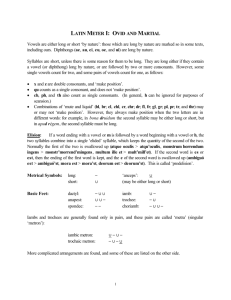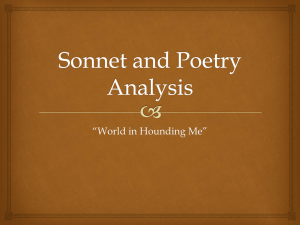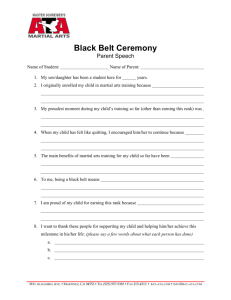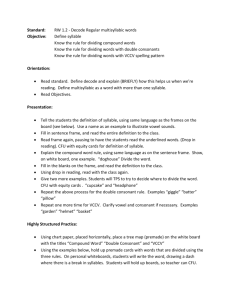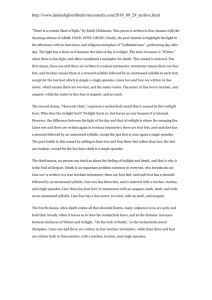here
advertisement
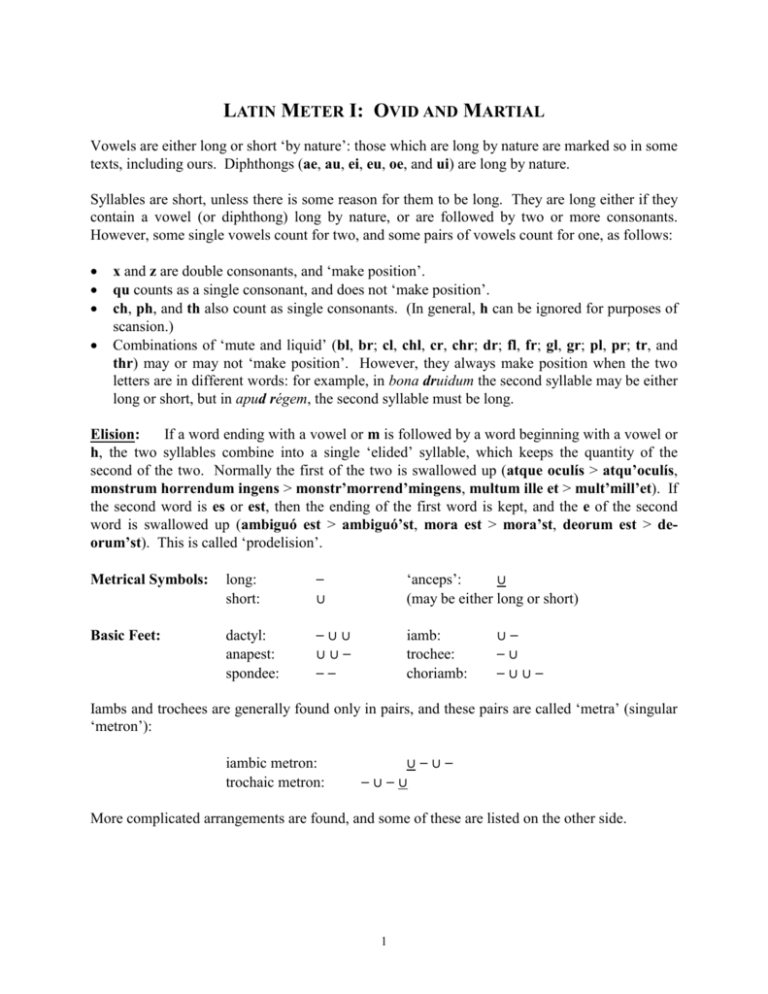
LATIN METER I: OVID AND MARTIAL Vowels are either long or short ‘by nature’: those which are long by nature are marked so in some texts, including ours. Diphthongs (ae, au, ei, eu, oe, and ui) are long by nature. Syllables are short, unless there is some reason for them to be long. They are long either if they contain a vowel (or diphthong) long by nature, or are followed by two or more consonants. However, some single vowels count for two, and some pairs of vowels count for one, as follows: x and z are double consonants, and ‘make position’. qu counts as a single consonant, and does not ‘make position’. ch, ph, and th also count as single consonants. (In general, h can be ignored for purposes of scansion.) Combinations of ‘mute and liquid’ (bl, br; cl, chl, cr, chr; dr; fl, fr; gl, gr; pl, pr; tr, and thr) may or may not ‘make position’. However, they always make position when the two letters are in different words: for example, in bona druidum the second syllable may be either long or short, but in apud régem, the second syllable must be long. Elision: If a word ending with a vowel or m is followed by a word beginning with a vowel or h, the two syllables combine into a single ‘elided’ syllable, which keeps the quantity of the second of the two. Normally the first of the two is swallowed up (atque oculís > atqu’oculís, monstrum horrendum ingens > monstr’morrend’mingens, multum ille et > mult’mill’et). If the second word is es or est, then the ending of the first word is kept, and the e of the second word is swallowed up (ambiguó est > ambiguó’st, mora est > mora’st, deorum est > deorum’st). This is called ‘prodelision’. Metrical Symbols: long: short: – u ‘anceps’: u (may be either long or short) Basic Feet: dactyl: anapest: spondee: –uu uu– –– iamb: trochee: choriamb: u– –u –uu– Iambs and trochees are generally found only in pairs, and these pairs are called ‘metra’ (singular ‘metron’): iambic metron: trochaic metron: u–u– –u–u More complicated arrangements are found, and some of these are listed on the other side. 1 Particular Latin Meters (Vergil, Ovid’s Metamorphoses, bits of Martial) Dactylic Hexameter (Hx) Six feet, of which the first five may be either dactyls or spondees, though the fifth is nearly always a dactyl, and the sixth must be either a spondee or a trochee. – uu – uu – uu – uu – uu –u (Ovid’s other works, Propertius, most of Martial) Elegiac Couplet (E) A dactylic hexameter followed by a so-called ‘elegiac pentameter’. Easy to recognize, because the pentameters are always indented in modern texts. – uu – uu – uu – uu – uu – u – uu – uu – | – uu – uu u Hendecasyllable (H) (a favorite of Catullus, frequent in Martial) Also known as a ‘Phalaecian’, after its Greek inventor. An irregularly arranged eleven-syllable line: – – – uu – u – u – u Iambic ‘Senarius’ (non-lyric parts of drama: not in Ovid or Martial) Three iambic metra, as defined above. Any long or anceps syllable may be resolved into double short. u–u– u–u– u–u– Scazon or ‘Limping Iamb’ (S) (frequent in Martial) Scazon is Greek for ‘limping’. The same as the iambic senarius, except that the third metron ‘drags’ or ‘limps’: its first syllable must be short, but the third is long: u–u– u–u– u––– 2
